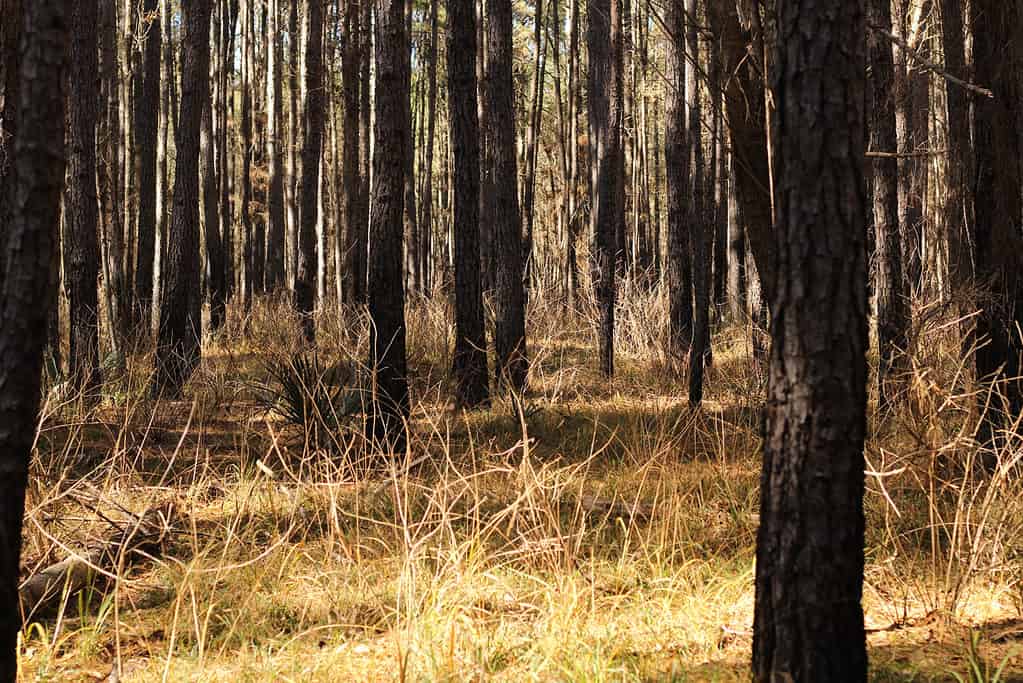Everything really is bigger in Texas! The expansive state boasts highly diverse ecosystems, despite popular beliefs to the contrary. It even has numerous forests! In fact, there are four national forests and one national grassland in the state. That area totals approximately 675,000 acres and gets managed by the U.S. Forest Service. The four Texas forest areas include Sabine National Forest, Angelina National Forest, Sam Houston National Forest, and Davy Crockett National Forest.
So, which one is the largest forest in the state? And what kind of animal life calls the region home? Keep reading to find out the answers to these questions!

What Is the Largest Forest in Texas?
The largest of the four forests spread throughout Texas is Sam Houston National Forest. The expansive land covers 163,037 acres and three counties. However, the forest is not entirely continuous. Numerous small farms and private lands are interspersed with federal property.
The national forest is also home to multiple archaeological sites. That is because of ample evidence that humans occupied the area as much as 12,000 years ago. The most recent hunter and gatherer groups known to occupy the land include the Deadose, Bidai, Akokisa, and Patiri. Unfortunately, all four people groups were extinct by the early 1800s. The pressure from settlers and the introduction of diseases led to their death.
Thanks, in part, to the relatively comfortable climate, Sam Houston National Forest is popular among outdoor adventure seekers. Its winters are mild and short, with an average temperature of 53°F. And the summers are as comfortable as one can expect in such a humid environment. The average temperature during the warmer months is 83°F. But it will often rise to the high 90s during the hottest periods.

The Sam Houston Forest has comfortable weather for most of the year, except for the hottest months.
©Jenniestanley/Shutterstock.com
Where Is Sam Houston National Forest Located on a Map?
Sam Houston National Forest is situated roughly 50 miles north of Houston. It is in part of San Jacinto, Montgomery, and Walker counties in Texas.
Recreation in Sam Houston National Forest
Sam Houston National Forest has two lakes perfect for water sports. You can take out your boat, waterski, paddleboard, or kayak during the summer. But some sections of the lakes are better suited for certain activities, so check conditions before you head out.
The park has 85 miles of multi-use trails, allowing visitors to head out with horses, bikes, or OHVs. But there are also nearly 130 miles of hiking trails available to visitors. You do want to use caution during hunting season, as many Lone Star Hiking Trail portions cross into hunting areas. Wear bright colors if you plan to hit the trail during this time of the year.
Texas’s largest national forest also has ample hunting and fishing opportunities. Plus, you can easily camp at one of the three campgrounds. Dispersed camping is permitted in some areas, but only during certain times of the year.
Five recreation areas and an expansive wilderness area offer additional opportunities for adventure in the spacious national forest. And keep an eye out for some of the abundant wildlife while hiking, lounging on the water, or enjoying a tasty picnic.
What Kinds of Wildlife Are in the Largest Forest in Texas?
Sam Houston National Forest is home to multiple endangered species. Lake Conroe and the surrounding land are a protected wintering space for the spectacular bald eagle. Additionally, the red-cockaded woodpecker calls much of the national forest home. So your outing may become even more special if you spot one of these beautiful creatures.
After the uniquely colored woodpecker drills its holes in trees, many other small animals quickly take up residence. Some of these include screech owls, bluebirds, squirrels, wood ducks, honey bees, and other woodpeckers.
But birds aren’t the only wildlife you may see on your outing. The most abundant four-legged creature is the deer. It is also the most common and popular animal to pursue during hunting season. Feral hogs, rabbits, and hares also roam the expansive wilderness.
Other animals you may spot include alligators, doves, quail, snakes, and ducks. Additionally, both lakes are simply teeming with fish. So if you want to catch a delicious dinner, you stand a good chance!
The photo featured at the top of this post is © Tyler Stuard/Shutterstock.com
Sources
- US Forest Service, Available here: https://www.fs.usda.gov/detail/texas/about-forest/districts/?cid=fswdev3_008443
- National Forests, Available here: https://www.nationalforests.org/our-forests/find-a-forest/angelina-davy-crockett-sabine-sam-houston-caddo-lbj-national-forests
FAQs (Frequently Asked Questions)
Are there alligators in Sam Houston National Forest?
Yes, there are some alligators living in the national forest. However, they are found at Huntsville State Park, which is a 200-acre park situated within the national forest.
What kind of snakes are in Sam Houston National Forest?
The Copperhead, Coral snake, Cottonmouth/Water Moccasin, and Rattlesnake all live within the national forest.
Can you camp for free in Sam Houston National Forest?
Yes! You can camp for free in Sam Houston National Forest. The Kelly’s Pond Campground offers eight primitive sites. Additionally, the Lone Star Trail Primitive Camp Number Two also has free camping. But head out early, as it is first-come-first-serve. All established campgrounds have a nightly fee, though it varies by location.
Thank you for reading! Have some feedback for us? Contact the AZ Animals editorial team.






